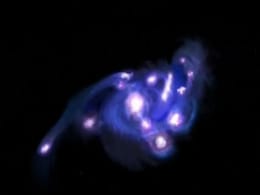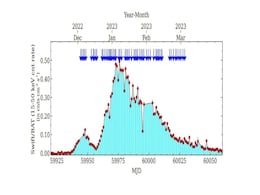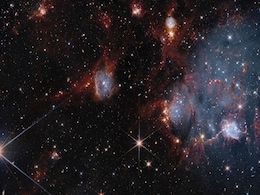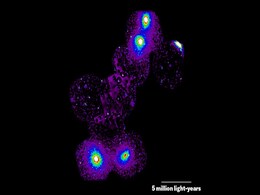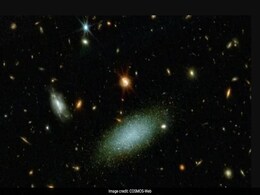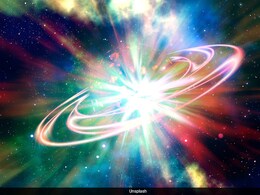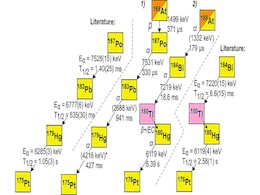Observable Universe
- All
- News
-

82% Human-Stray Dog Encounters In India "Neutral": Research
- Wednesday August 13, 2025
- India News | Press Trust of India
Human-street dog interactions in India are predominantly uneventful with 82 per cent of observed encounters involving approachable or neutral behaviour, according to a research on street dogs and public health by the University of Edinburgh.
-
 www.ndtv.com
www.ndtv.com
-

Astronomers Discover "Cosmic Grapes" Galaxy Packed with Star-Forming Clumps in the Early Universe
- Friday August 15, 2025
- Written by Gadgets 360 Staff
The "Cosmic Grapes" galaxy discovery sheds new light on early galaxy formation, revealing unexpected dense, star-forming clumps just 930 million years post-Big Bang. Uncovered through JWST, ALMA, and gravitational lensing, this breakthrough opens new opportunities for understanding the early cosmos.
-
 www.gadgets360.com
www.gadgets360.com
-

Chinese Astronomers Use Insight-HXMT to Decode X-ray Outburst of Binary Star System
- Tuesday August 5, 2025
- Written by Gadgets 360 Staff
In a recent study published on July 24 via arXiv, astronomers from Wuhan University have detailed the powerful X-ray outburst of the Be/X-ray binary system RX J0440.9+4431. Using China’s Insight-HXMT satellite, the team tracked the event from its eruption in December 2022 through March 2023.
-
 www.gadgets360.com
www.gadgets360.com
-

NASA’s Hubble and Webb Discover Bursting Star Formation in Small Magellanic Cloud
- Saturday July 12, 2025
- Written by Gadgets 360 Staff
NASA’s Hubble and Webb telescopes have captured spectacular images of NGC 460 and NGC 456, two star clusters in the Small Magellanic Cloud. These young, open clusters are filled with massive, hot stars that trigger new star formation by carving nebulae. The findings provide insights into early universe conditions and interstellar medium behaviour...
-
 www.gadgets360.com
www.gadgets360.com
-

Scientists Trace Universe’s Missing Ordinary Matter Using FRBs and X-rays
- Wednesday July 9, 2025
- Written by Gadgets 360 Staff
New astronomical breakthroughs have identified where the universe’s “missing” ordinary matter resides. Using 70 FRBs, including one from 9 billion light-years away, scientists discovered that 76% of ordinary matter exists between galaxies. A separate X-ray study observed an enormous hot gas filament connecting galaxy clusters.
-
 www.gadgets360.com
www.gadgets360.com
-

'Writing Is Thinking': Do Students Who Use ChatGPT Learn Less?
- Wednesday July 2, 2025
- World News | Agence France-Presse
When Jocelyn Leitzinger had her university students write about times in their lives they had witnessed discrimination, she noticed that a woman named Sally was the victim in many of the stories. Around half of her 180 students used ChatGPT for it.
-
 www.ndtv.com
www.ndtv.com
-

James Webb Telescope Unveils Largest-Ever Map Of The Universe, Reveals 800,000 Galaxies
- Thursday June 12, 2025
- Science | Edited by Ritu Singh
Spanning 98% of the universe's timeline, this comprehensive dataset was made possible by the James Webb Space Telescope's 255 hours of observation.
-
 www.ndtv.com
www.ndtv.com
-

Scientists Observe Light Of "Cosmic Dawn" With Telescope On Earth For The First Time Ever
- Thursday June 12, 2025
- Science | Edited by Srishti Singh Sisodia
Cosmic dawn insights shed light on the universe's early stages, providing an understanding of the universe's origins.
-
 www.ndtv.com
www.ndtv.com
-

Scientists Discover Heaviest Proton-Emitting Nucleus After Nearly 30 Years
- Sunday June 8, 2025
- Written by Gadgets 360 Staff
Researchers at Finland’s University of Jyväskylä have identified astatine-188, the heaviest atomic nucleus yet known to undergo proton emission. This rare radioactive decay challenges established nuclear models and offers new insight into the structure and stability of exotic isotopes. The breakthrough, published in Nature Communications, marks...
-
 www.gadgets360.com
www.gadgets360.com
-

China Develops Laser Tech That Can Read Tiny Text From Nearly 2km Away
- Thursday May 29, 2025
- Science | Edited by Bhavya Sukheja
Scientists in China say they have developed a laser that can observe tiny text and other fine details at a higher resolution from a distance of 1.36 kilometres.
-
 www.ndtv.com
www.ndtv.com
-

Astronomers Spot Galaxy Shaped Like Milky Way But Is Far More Massive
- Friday May 23, 2025
- World News | Reuters
Astronomers have observed a galaxy dating to an earlier epoch in the universe's history that surprisingly is shaped much like our Milky Way but far more massive, offering new insight into galactic formation.
-
 www.ndtv.com
www.ndtv.com
-

New Study Reveals Recent Ice Gains in Antarctica, But Long-Term Melting Continues
- Saturday May 17, 2025
- Written by Gadgets 360 Staff
A study led by researchers at Tongji University using NASA's GRACE satellites has observed recent ice gains in Antarctica from 2021 to 2023, mainly due to unusual precipitation. However, the long-term satellite data from 2002 to 2020 shows a significant and accelerating trend of ice loss. However, experts emphasize this short-term gain does not rev...
-
 www.gadgets360.com
www.gadgets360.com
-

"Restore 100 Acres Or...": Supreme Court On Hyderabad University Land Row
- Wednesday April 16, 2025
- India News | NDTV News Desk
The Supreme Court made searing observations about the Telangana government's rushed deforestation of an estimated 100 acres in Hyderabad's Kancha Gachibowli area, near the Hyderabad Central University campus, "without permission of authorities".
-
 www.ndtv.com
www.ndtv.com
-

Scientists Spot a Key Difference in Matter and Antimatter Decay
- Tuesday April 1, 2025
- Written by Gadgets 360 Staff
A major difference in the decay of matter and antimatter has been observed in beauty-lambda baryons, according to new research from the LHCb experiment at CERN. The discovery provides insight into why the universe contains more matter than antimatter. Scientists found that the chance of this decay difference occurring randomly is less than one in t...
-
 www.gadgets360.com
www.gadgets360.com
-

Did Black Hole Radiation Shape the Universe?
- Saturday March 29, 2025
- Written by Gadgets 360 Staff
A study suggests that Hawking radiation, first proposed by Stephen Hawking, may have influenced the universe’s structure. According to reports, primordial black holes that existed in the early universe could have evaporated through Hawking radiation, impacting matter distribution. The research explores how these black holes might have shaped gala...
-
 www.gadgets360.com
www.gadgets360.com
-

82% Human-Stray Dog Encounters In India "Neutral": Research
- Wednesday August 13, 2025
- India News | Press Trust of India
Human-street dog interactions in India are predominantly uneventful with 82 per cent of observed encounters involving approachable or neutral behaviour, according to a research on street dogs and public health by the University of Edinburgh.
-
 www.ndtv.com
www.ndtv.com
-

Astronomers Discover "Cosmic Grapes" Galaxy Packed with Star-Forming Clumps in the Early Universe
- Friday August 15, 2025
- Written by Gadgets 360 Staff
The "Cosmic Grapes" galaxy discovery sheds new light on early galaxy formation, revealing unexpected dense, star-forming clumps just 930 million years post-Big Bang. Uncovered through JWST, ALMA, and gravitational lensing, this breakthrough opens new opportunities for understanding the early cosmos.
-
 www.gadgets360.com
www.gadgets360.com
-

Chinese Astronomers Use Insight-HXMT to Decode X-ray Outburst of Binary Star System
- Tuesday August 5, 2025
- Written by Gadgets 360 Staff
In a recent study published on July 24 via arXiv, astronomers from Wuhan University have detailed the powerful X-ray outburst of the Be/X-ray binary system RX J0440.9+4431. Using China’s Insight-HXMT satellite, the team tracked the event from its eruption in December 2022 through March 2023.
-
 www.gadgets360.com
www.gadgets360.com
-

NASA’s Hubble and Webb Discover Bursting Star Formation in Small Magellanic Cloud
- Saturday July 12, 2025
- Written by Gadgets 360 Staff
NASA’s Hubble and Webb telescopes have captured spectacular images of NGC 460 and NGC 456, two star clusters in the Small Magellanic Cloud. These young, open clusters are filled with massive, hot stars that trigger new star formation by carving nebulae. The findings provide insights into early universe conditions and interstellar medium behaviour...
-
 www.gadgets360.com
www.gadgets360.com
-

Scientists Trace Universe’s Missing Ordinary Matter Using FRBs and X-rays
- Wednesday July 9, 2025
- Written by Gadgets 360 Staff
New astronomical breakthroughs have identified where the universe’s “missing” ordinary matter resides. Using 70 FRBs, including one from 9 billion light-years away, scientists discovered that 76% of ordinary matter exists between galaxies. A separate X-ray study observed an enormous hot gas filament connecting galaxy clusters.
-
 www.gadgets360.com
www.gadgets360.com
-

'Writing Is Thinking': Do Students Who Use ChatGPT Learn Less?
- Wednesday July 2, 2025
- World News | Agence France-Presse
When Jocelyn Leitzinger had her university students write about times in their lives they had witnessed discrimination, she noticed that a woman named Sally was the victim in many of the stories. Around half of her 180 students used ChatGPT for it.
-
 www.ndtv.com
www.ndtv.com
-

James Webb Telescope Unveils Largest-Ever Map Of The Universe, Reveals 800,000 Galaxies
- Thursday June 12, 2025
- Science | Edited by Ritu Singh
Spanning 98% of the universe's timeline, this comprehensive dataset was made possible by the James Webb Space Telescope's 255 hours of observation.
-
 www.ndtv.com
www.ndtv.com
-

Scientists Observe Light Of "Cosmic Dawn" With Telescope On Earth For The First Time Ever
- Thursday June 12, 2025
- Science | Edited by Srishti Singh Sisodia
Cosmic dawn insights shed light on the universe's early stages, providing an understanding of the universe's origins.
-
 www.ndtv.com
www.ndtv.com
-

Scientists Discover Heaviest Proton-Emitting Nucleus After Nearly 30 Years
- Sunday June 8, 2025
- Written by Gadgets 360 Staff
Researchers at Finland’s University of Jyväskylä have identified astatine-188, the heaviest atomic nucleus yet known to undergo proton emission. This rare radioactive decay challenges established nuclear models and offers new insight into the structure and stability of exotic isotopes. The breakthrough, published in Nature Communications, marks...
-
 www.gadgets360.com
www.gadgets360.com
-

China Develops Laser Tech That Can Read Tiny Text From Nearly 2km Away
- Thursday May 29, 2025
- Science | Edited by Bhavya Sukheja
Scientists in China say they have developed a laser that can observe tiny text and other fine details at a higher resolution from a distance of 1.36 kilometres.
-
 www.ndtv.com
www.ndtv.com
-

Astronomers Spot Galaxy Shaped Like Milky Way But Is Far More Massive
- Friday May 23, 2025
- World News | Reuters
Astronomers have observed a galaxy dating to an earlier epoch in the universe's history that surprisingly is shaped much like our Milky Way but far more massive, offering new insight into galactic formation.
-
 www.ndtv.com
www.ndtv.com
-

New Study Reveals Recent Ice Gains in Antarctica, But Long-Term Melting Continues
- Saturday May 17, 2025
- Written by Gadgets 360 Staff
A study led by researchers at Tongji University using NASA's GRACE satellites has observed recent ice gains in Antarctica from 2021 to 2023, mainly due to unusual precipitation. However, the long-term satellite data from 2002 to 2020 shows a significant and accelerating trend of ice loss. However, experts emphasize this short-term gain does not rev...
-
 www.gadgets360.com
www.gadgets360.com
-

"Restore 100 Acres Or...": Supreme Court On Hyderabad University Land Row
- Wednesday April 16, 2025
- India News | NDTV News Desk
The Supreme Court made searing observations about the Telangana government's rushed deforestation of an estimated 100 acres in Hyderabad's Kancha Gachibowli area, near the Hyderabad Central University campus, "without permission of authorities".
-
 www.ndtv.com
www.ndtv.com
-

Scientists Spot a Key Difference in Matter and Antimatter Decay
- Tuesday April 1, 2025
- Written by Gadgets 360 Staff
A major difference in the decay of matter and antimatter has been observed in beauty-lambda baryons, according to new research from the LHCb experiment at CERN. The discovery provides insight into why the universe contains more matter than antimatter. Scientists found that the chance of this decay difference occurring randomly is less than one in t...
-
 www.gadgets360.com
www.gadgets360.com
-

Did Black Hole Radiation Shape the Universe?
- Saturday March 29, 2025
- Written by Gadgets 360 Staff
A study suggests that Hawking radiation, first proposed by Stephen Hawking, may have influenced the universe’s structure. According to reports, primordial black holes that existed in the early universe could have evaporated through Hawking radiation, impacting matter distribution. The research explores how these black holes might have shaped gala...
-
 www.gadgets360.com
www.gadgets360.com


